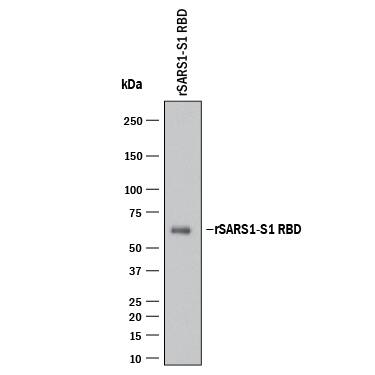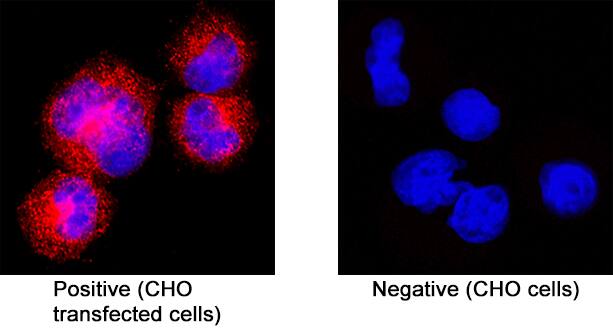SARS-CoV-2 Spike RBD Antibody
R&D Systems, part of Bio-Techne | Catalog # MAB10827


Conjugate
Catalog #
Key Product Details
Species Reactivity
SARS-CoV-2
Applications
Flow Cytometry, Immunocytochemistry, Western Blot
Label
Unconjugated
Antibody Source
Monoclonal Mouse IgG2A Clone # 1042425
Product Specifications
Immunogen
Chinese Hamster Ovary cell line CHO-derived SARS-CoV Spike RBD
Arg306-Phe527
Accession # NP_0828851.1
Arg306-Phe527
Accession # NP_0828851.1
Specificity
Detects SARS-CoV Spike RBD in direct ELISAs.
Clonality
Monoclonal
Host
Mouse
Isotype
IgG2A
Scientific Data Images for SARS-CoV-2 Spike RBD Antibody
Detection of SARS-CoV-2 Spike RBD by Western Blot.
Western blot shows recombinant SARS-CoV-2 Spike S1 RBD. PVDF membrane was probed with 2 µg/mL of Mouse Anti-SARS-CoV-2 Spike RBD Monoclonal Antibody (Catalog # MAB10827) followed by HRP-conjugated Anti-Mouse IgG Secondary Antibody (HAF018). A specific band was detected for Spike RBD at approximately 60 kDa (as indicated). This experiment was conducted under reducing conditions and using Western Blot Buffer Group 1.Detection of SARS-CoV-2 Spike S1 protein bound to ACE-2 in HEK293 Human Cell Line Transfected with Human ACE-2 and eGFP by Flow Cytometry.
HEK293 human embryonic kidney cell line transfected with human ACE-2 and eGFP was incubated with Recombinant SARS-CoV-2 Spike S1 Subunit His-Tag protein (10522-CV), then stained with (A) Mouse Anti-SARS-CoV-2 Spike S1 Monoclonal Antibody (Catalog # MAB10827) or (B) Mouse IgG2A Isotype Control Antibody (MAB003) followed by Allophycocyanin-conjugated Anti-Mouse IgG Secondary Antibody (F0101B). Staining was performed using our Staining Membrane-associated Proteins protocol.Detection of Spike RBD in CHO Chinese hamster ovary cell line.
Spike RBD was detected in immersion fixed CHO Chinese hamster ovary cell line transfected with SARS-CoV-2 (positive staining) and CHO Chinese hamster ovary cell line (non-transfected, negative staining) using Mouse Anti-SARS-CoV-2 Spike RBD Monoclonal Antibody (Catalog # MAB10827) at 8 µg/mL for 3 hours at room temperature. Cells were stained using the NorthernLights™ 557-conjugated Anti-Mouse IgG Secondary Antibody (red; Catalog # NL007) and counterstained with DAPI (blue). Specific staining was localized to cytoplasm. View our protocol for Fluorescent ICC Staining of Cells on Coverslips.Applications for SARS-CoV-2 Spike RBD Antibody
Application
Recommended Usage
Flow Cytometry
0.25 µg/106 cells
Sample: SARS-CoV-2 Spike S1 protein bound to ACE-2 in HEK293 Human Cell Line Transfected with Human ACE-2 and eGFP
Sample: SARS-CoV-2 Spike S1 protein bound to ACE-2 in HEK293 Human Cell Line Transfected with Human ACE-2 and eGFP
Immunocytochemistry
3-25 µg/mL
Sample: immersion fixed CHO cell line transfected with SARS-CoV-2 Spike
Sample: immersion fixed CHO cell line transfected with SARS-CoV-2 Spike
Western Blot
2 µg/mL
Sample: Recombinant SARS-CoV-2 Spike S1 RBD
Sample: Recombinant SARS-CoV-2 Spike S1 RBD
Formulation, Preparation, and Storage
Purification
Protein A or G purified from hybridoma culture supernatant
Reconstitution
Reconstitute at 0.5 mg/mL in sterile PBS. For liquid material, refer to CoA for concentration.
Formulation
Lyophilized from a 0.2 μm filtered solution in PBS with Trehalose. *Small pack size (SP) is supplied either lyophilized or as a 0.2 µm filtered solution in PBS.
Shipping
Lyophilized product is shipped at ambient temperature. Liquid small pack size (-SP) is shipped with polar packs. Upon receipt, store immediately at the temperature recommended below.
Stability & Storage
Use a manual defrost freezer and avoid repeated freeze-thaw cycles.
- 12 months from date of receipt, -20 to -70 °C as supplied.
- 1 month, 2 to 8 °C under sterile conditions after reconstitution.
- 6 months, -20 to -70 °C under sterile conditions after reconstitution.
Background: Spike RBD
References
- Rota, P.A. et al. (2003) Science 300:1394.
- Bosch, B.J. et al. (2003). J. Virol. 77:8801.
- Belouzard, S. et al. (2009) Proc. Natl. Acad. Sci. USA 106:5871.
- Millet, J.K. and G. R. Whittaker (2015) Virus Res. 202:120.
- Li, W. et al. (2003) Nature 426:450.
- Wong, S.K. et al. (2004) J. Biol. Chem. 279:3197.
- Ortega, J.T. et al. (2020) EXCLI J. 19:410.
- Du, L. el al. (2009) Nat. Rev. Microbiol. 7:226.
Long Name
Spike Receptor Binding Domain
Gene Symbol
S
UniProt
Additional Spike RBD Products
Product Documents for SARS-CoV-2 Spike RBD Antibody
Product Specific Notices for SARS-CoV-2 Spike RBD Antibody
For research use only
